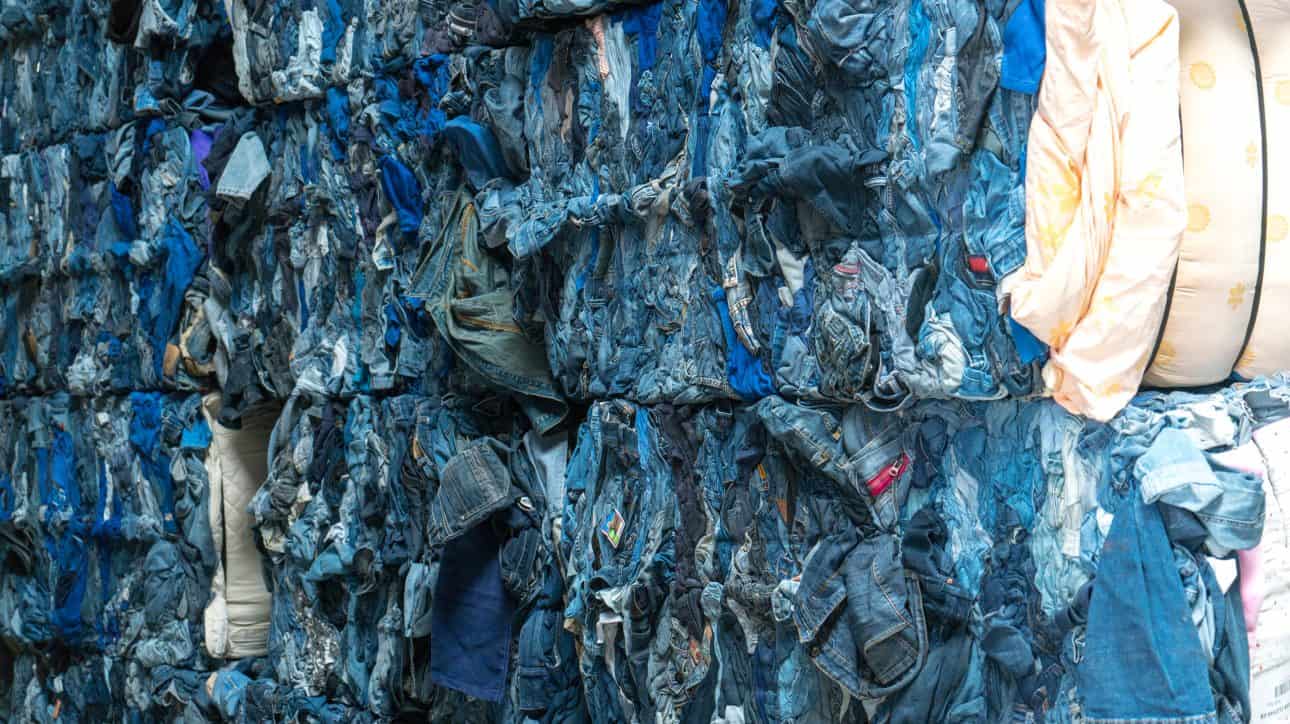Making Textile-to-Textile Recycling a Reality with SuperCircle

The Best Practice series sees Textile Exchange tap industry insiders to share their expertise on specialist subjects, highlighting the actions taken from the perspective of those at the forefront of these conversations.
In theory, textile-to-textile recycling has a lot of potential to help create a more sustainable future for the fashion, textile, and apparel industry. On the ground, the processes needed to make it happen are extremely complex. How do we collect unwanted clothes? Who sorts this waste by the type of fiber used? And how do we improve the technology available to turn old garments into new materials?
SuperCircle exists to help make textile-to-textile recycling a working reality. The tech and reverse logistics company does this by connecting the fashion and retail sector to post-consumer textile waste and recycling infrastructure, filling a crucial logistical gap in the circular textile economy.
We spoke the team behind SuperCircle; Chloe Songer, Stuart Ahlum, and Phong Nguyen, to unpick their innovative business model, delving deeper into the practical steps needed to scale recycling solutions and save discarded textiles from ending up in landfill.
What inspired you to approach textile recycling from this angle?
Prior to launching SuperCircle, we founded Thousand Fell, our circular sneaker brand. In running Thousand Fell, we recognized that while material innovation and recycling technology were mature enough to effectively support circular business models, the sorting, processing, and logistics infrastructure needed for recapturing garments was non-existent. SuperCircle was built to fill this gap and make circularity a reality today.
“While material innovation and recycling technology were mature enough to effectively support circular business models, the sorting, processing, and logistics infrastructure needed for recapturing garments was non-existent.”
What are your top priorities in terms of barriers to overcome?
The biggest barrier for SuperCircle is the education gap within the retail industry around what true circularity is, and what a north star for circularity should look like. This education gap is understandable — the circular supply chain is new and it’s complicated, which requires a lot of education and reorientation for brands and sustainability leads.
We help brands and the retail industry understand this by simplifying our mission to “ending textile waste.” We describe this as keeping textiles out of landfill and away from overwhelmed resale markets in the Majority World.
To meet that mission, we have built SuperCircle to take back any kind of textiles to be recycled. Some of these recycling solutions are higher value and more in line with where we want to see circularity go — namely, with fiber-to-fiber (F2F) and componentry-to-componentry (C2C) recycling.
We also work within the limitations of current garment constructions and material compositions, deploying solutions that, while not as ideal as F2F and C2C recycling, are still better alternatives to landfill and international export. This includes open-loop recycling (downcycling and upcycling), as well as energy recovery when necessary.
These solutions make for a more responsible and traceable end-of-life solution for a garment. We help brands and the retail industry understand this waste hierarchy and showcase a clear path forward towards garment recapture and fiber-to-fiber recycling.
“The circular supply chain is new and it’s complicated, which requires a lot of education and reorientation for brands and sustainability leads.”
What is the biggest blocker preventing the industry from recycling old clothes into new ones?
The biggest challenge for fiber-to-fiber recycling (especially with post-consumer garments) is the cultivation of clean material feeds. It requires the identification, collection, sortation, and aggregation of garments into feeds containing the same fibers, such as cotton with cotton, wool with wool, etc.
When garments are so often constructed with blended fibers — or the material composition is unknown — this poses a big challenge for building these clean material feeds and enabling fiber-to-fiber recycling.
Additionally, for the most part, finished garments aren’t viable feedstock for recyclers. They need to be processed: trimmed, shredded, baled, and more, then delivered in bulk in order to be effectively recycled. This processing component is a critical step for fiber-to-fiber recycling that SuperCircle addresses.
“The biggest challenge for fiber-to-fiber recycling (especially with post-consumer garments) is the cultivation of clean material feeds.”
What do you think is needed within brands and retailers to improve understanding of how circularity works?
For the industry to successfully adopt circular systems and fiber-to-fiber recycling, it needs to build knowledge among its executive teams and decision-makers about circularity, as well as an understanding of the waste hierarchy compared to impact.
We are leaning in to create clarity for retail executive teams and decision-makers around the driving factors for fiber-to-fiber recycling. In practice, this means education and thought leadership that highlights the nuances — and readily available implementation — of circular systems. We’re leading seminars with executive teams, building case studies around profitable circular systems, and showcasing viability through pre-commercial programs.
SuperCircle is also working to showcase that while recycling is at the end of the waste hierarchy, it has the largest impact. This is in slight conflict with the ideal lifecycle of a garment — reuse, then repair, then resale, and then finally recycling.
The reality of the situation is that most garments — whether due to the product category, quality, price point, or consumer demand — don’t fit within the reuse / repair / resale channels. Recycling is realistically the best solution for the lion’s share of the industry’s product assortment.
“The reality of the situation is that most garments — whether due to the product category, quality, price point, or consumer demand — don’t fit within the reuse / repair / resale channels.”
For brands looking to get started with textile-to-textile recycling, what first steps do they need to take?
The two most important steps that a brand can take towards textile-to-textile recycling are:
- Designing products that can be recycled. This includes thinking through and mapping the material composition, garment construction, and making decisions up front that make recycling feasible.
- Incorporating a takeback program from the outset. Textiles, footwear, and accessories aren’t municipally recyclable. Brands need to launch take back programs to recapture their own garments. We don’t believe that a garment isn’t 100% recyclable if there isn’t a viable recycling channel. And this is one place where SuperCircle can help brands.
To that end, raw material decisions are incredibly important and, fortunately, design leads and production leads are starting to think through these decisions at the outset. They’re steering away from natural / synthetic blends, are using core monofibers like cotton, wool, silk, or biobased polyesters, and are thinking about how a garment can be deconstructed end-of-life.
These choices allow garments to more effectively be recycled. SuperCircle is also guiding brands through these future assortment decisions with circularity in mind. And while some legacy garments currently in circulation are likely to be eligible only for downcycling – our team is able to provide insights and help design teams determine shifts that can be made for future garments to be eligible for fiber-to-fiber recycling.
“Raw material decisions are incredibly important and, fortunately, design leads and production leads are starting to think through these decisions at the outset.”
To what extent does circularity require consumers to change their habits?
To be truly successful, we do need consumers to help end textile waste. The circular economy requires participation – if consumers are given all the tools, incentives, and information they need to participate, then brand-owned circularity programs will succeed. We believe it is about ease and education. Some customers are interested in the easiest way to do something, and some are more interested in learning about how and why. There is no right answer here, and brands need to think about what will help and incentivize their customers to be part of a circularity program.
On a larger scale, policy can enable this change for consumers. If brands must offer end-of-life solutions for their products through extended producer responsibility legislation, then over time that will naturally shift the consumers perspective and eventual participation in these types of programs.
“The circular economy requires participation – if consumers are given all the tools, incentives, and information they need to participate, then brand-owned circularity programs will succeed.”
How important is collaboration to you?
Collaboration is essential to the scaling and the success of circularity programs and extended producer responsibility. Businesses need to tackle different aspects of the problem of textile waste to enable the most holistic solutions. We sit on multiple boards, including the American Circular Textiles group to collaborate on lobbying for federal circularity policy for textiles.
Collaboration for us also comes in the form of our recycling and sorting partners. There is incredible innovation occurring in this space right now, and we are working together to enable scalable and technology-driven solutions with the brightest minds working on textile recycling right now.
We also work closely with resale providers to launch and operate 360° circularity programs. While we believe that recycling has the largest impact, we also understand that there are garments that can (and should) be resold first. We want to support those initiatives and work with several incredible partners to support and augment those efforts.


